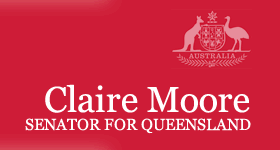Senator MOORE (Queensland)
Senator MOORE (Queensland) (23:54): Two years ago in this place the then Prime Minister, Kevin Rudd, made an incredibly important statement to the people of Australia. He made an apology to the people that we knew up until that day as the forgotten Australians. In that statement he said:
I offer you this profound apology. To apologise for the pain that has been caused. To apologise for the failure to offer proper care. To apologise for those who have gone before us and ignored your cries for help. Because children, it seems, were not to be believed. Only those in authority, it seems, were the ones to be believed. To apologise for denying you basic life opportunities, including so often a decent education. To apologise also, for just how long it has taken for the Australian government to say sorry-so many Senate reports, nearly a decade of deliberation, and a unanimous recommendation that the Commonwealth apologise. And finally we do so today.
For the hundreds of people who came to share in that apology, for all the people who were watching it, listening, waiting, many of us crying, that was a very important moment. Mr Rudd then went on to say:
It is important that this not be regarded as a single point in history. Our view is that it would be helpful for the nation, however painful, to properly record your experiences, where you deem that to be appropriate. This can assist the nation to learn from your experiences. As a result, the Australian government is supporting projects with both the National Library and the National Museum which will provide future generations with a solemn reminder of the past. To ensure not only that your experiences are heard, but also that they will never ever be forgotten.
Last week, two years after the initial apology, at the National Museum the exhibit was opened which fulfils that promise. I particularly want to thank Dr Mike Pickering, Dr Jay Arthur and Dr Adele Chynoweth, who created an exhibition which now is in our museum called Inside: Life in Children's Homes and Institutions. This is not an easy place to go. This is not a calm, light afternoon's entertainment. When you go into this exhibition-and I urge people to go and see this exhibition-you are drawn into a world which many of us in this Senate heard about during the Senate inquiries. But the way they present it at the National Museum is that you go into quite a darkened place and you wander through and see stories of people who actually lived the life in institutions. They share with us their pain and their sudden laughter, too, because what we heard was that people also could make their own fun. But it is a reminder to all of us of this shameful period in our history which we need to acknowledge. We need to continually respond and to assure people that now, as the Prime Minister said, they are believed.
A number of things came to mind as I wandered through. I spent several hours there and I hope to go back. I will mention some of the exhibits which remind us so much. There is one there that says, 'I am 82 years old and these memories remain clear. What happened to our childhood?' There is a clear statement as you go in that restates the words on the gates of one of the children's homes. As you walk through you go past the beautiful memories quilt that was created a couple of years ago, made out of handkerchiefs with people's stories and names embroidered. A film replays the apology and filmed versions of the impact the apology had. My friend Leonie Sheedy, who works with CLAN, and many of the other members of CLAN are there on film talking about their stories.
As you walk through there are wonderful photographs that have been given by the people to share their experiences and to help show such a poignant part of our history. One of my particular favourites is from Colleen from Queensland, who was actually at the infamous orphanage at Neerkol outside Rockhampton. Colleen told me she had got a special frock for the opening because she was so proud and excited to be there. She told me about how she gathered together her memories. Hanging in the exhibit is a scarf which Colleen had, and it was clear that when she was at that orphanage she had her scarf. She was No. 11.
We hear about individuals losing their individual nature as they were caught up in the institutions. Kerry, who was in one of the homes, said, 'In institutions the person is lost. The child is lost.' Who was Kerry? What colours did she like? Who was that person? You move forward and see the loss of childhood, the loss of opportunity.
There is a small teddy bear which is being featured on the promotional material for this exhibit. The story of the teddy bear is that young children did not have individual toys. They were not given those things. In fact, if toys were provided they were kept away and only brought out when there were visitors present, to give the image of a happy, peaceful society in the homes. It is an irony that the teddy bear that is featured and had been provided to the children's home had been made by Pentridge prisoners. In one form of institution goods were being made that were given to people who were living out their young lives in another form of institution.
Pamella's story, and Pamella gave evidence at all the inquiries and now remains active in support groups, is in the exhibition. It talks about when she was taken to the home her personal belongings were taken from her-a doll and some other personal belongings. Many years later, her sister recreated those gifts and gave them back to her as a middle-aged woman. She was telling us that the impact of seeing these clear mementos of what she had had and then had lost was so important to her.
My friend Juanita Barr, from Queensland, gives us such pleasure at all our commemorative days. Her beautiful, poignant voice sings the signature song Nobody Knows the Trouble I've Seen. As you wander through the beautifully curated museum, the way it has been presented makes you feel as though you can hear the voices around you. You are wandering around reading the stories and seeing the exhibits and you feel as though you can hear children's voices. It is very effectively done. What must be remembered is that at the time those children did not have a voice. Now, with history, we are able to ensure that we will not forget that they had those experiences.
As I said before, one of the most frustrating elements is that we did not know. The wider community was unaware of what was happening. One of the exhibits is a collection box. Many of the homes had charity drives to raise money to keep them going. As I said when I spoke about one of the stolen generation-forgotten Australians reports, what stayed with me was that at the same time as I was going to schools in the Queensland system my mother was involved, as many people were, in active fundraising activities to give money to the homes that were there. None of us knew what was going on behind those large gates, and I sometimes wonder. If my mother had ever known, I think there would have been some changes in the history at the time.
At the time when we brought forward the reports, there were many calls for what was going to happen next. In opening the exhibition last week, Minister Macklin was able to talk about further action that the government has taken with the Find and Connect Service, with support and through engaging people in where we go next. This is an ongoing process. The fact that we had the apology, the fact that now we have the National Museum exhibits-and the National Library work-are important steps along the way. But we have an ongoing responsibility to these people to ensure that they have the services that they need as they continue to struggle with the impact of the time they had under state care, under charity care and in institutions. Minister Macklin also said that this exhibit was actually called for by the CLAN group during the process we had. I clearly remember this evidence and I want to end with this. CLAN said that they wanted to have the National Library and the national history processes, and they went on to say:
Let our histories be visible.
Get the dinosaurs out of the Australian museum ... and dedicate it to orphanages and children.
As I have said, the forgotten Australians will not be forgotten anymore.




